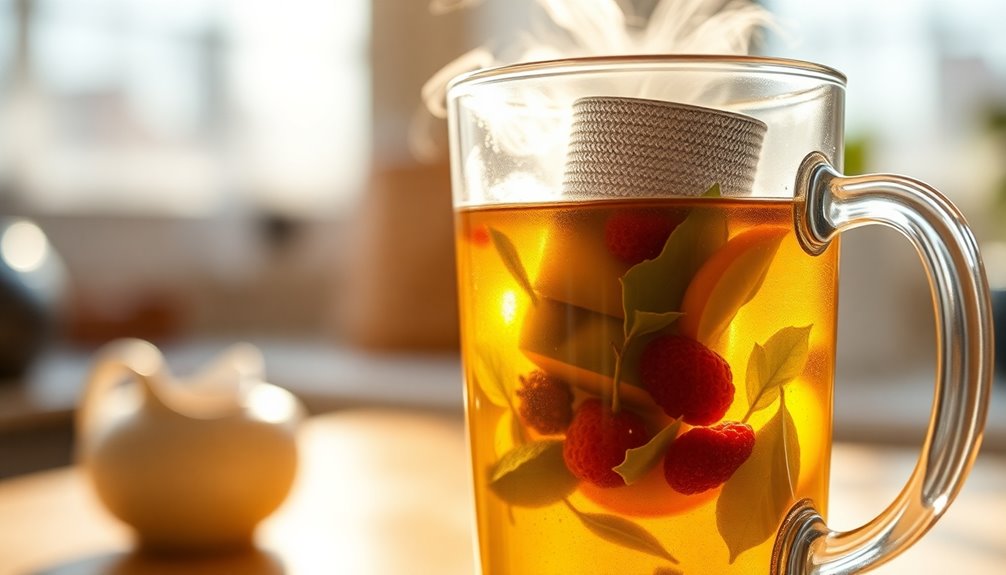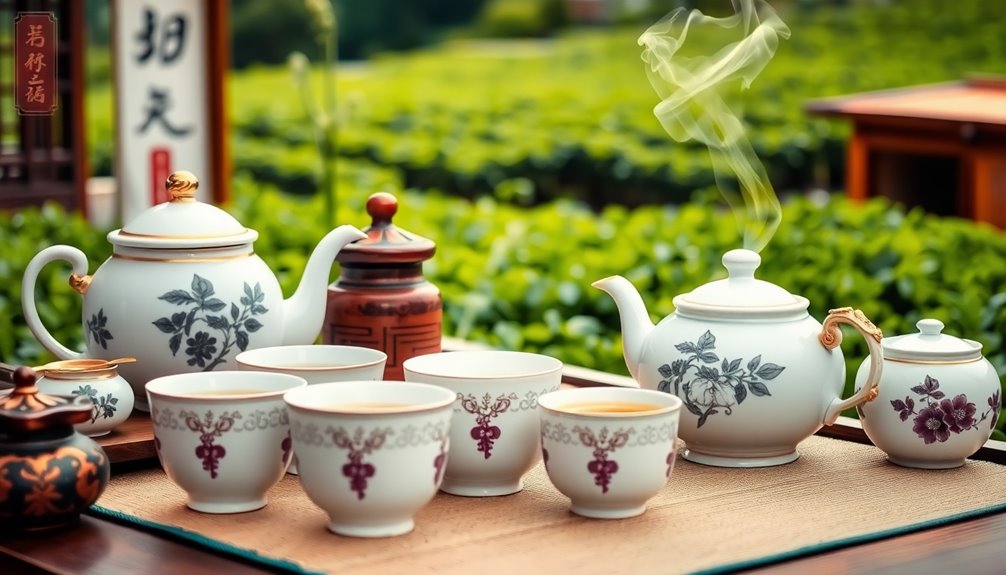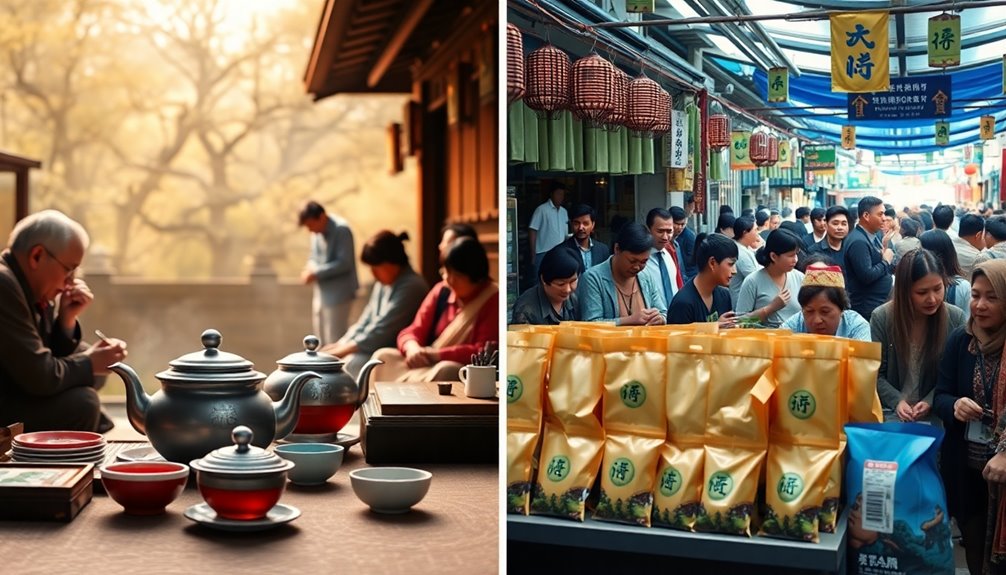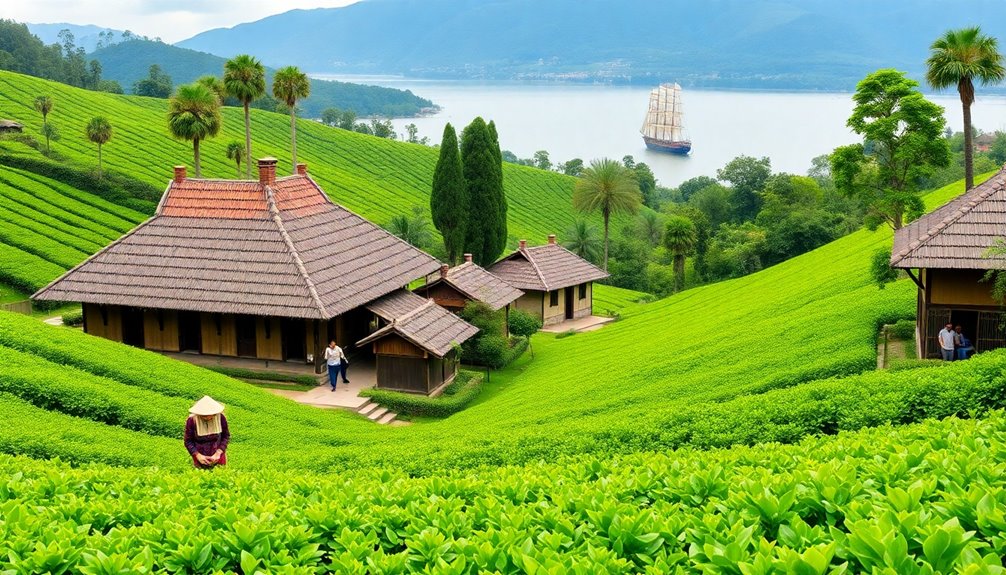Tea's journey began in ancient China around 2737 B.C.E., thanks to Emperor Shen Nong's discovery. Initially prized for its health benefits, it evolved into a daily ritual by 300 A.D. As tea spread to Japan and Europe through traders, it influenced customs worldwide. The British East India Company made tea a staple in England, giving rise to the afternoon tea tradition. Despite its cultural significance, the tea trade also had darker implications, linked to colonial exploitation and political unrest. You'll discover even more fascinating details about tea's global impact and cultural roles that have shaped its history.
Key Takeaways
- Tea originated in ancient China around 2737 B.C.E., initially valued for its medicinal properties before becoming a daily necessity by 300 A.D.
- The Tang Dynasty (618-907 A.D.) marked a significant cultural blossoming of tea, influencing its subsequent global spread.
- Portuguese traders introduced tea to Europe in the 16th century, with the British East India Company popularizing it in England by the 18th century.
- The Boston Tea Party in 1773 symbolized tea's political significance in America, highlighting its role in colonial resistance against British control.
- Today, tea is enjoyed worldwide, with over 600 million cups consumed daily in India, reflecting its cultural and social importance.
Introduction

Tea, a beverage steeped in history, has journeyed through cultures and centuries, shaping traditions and societies along the way. It all began in ancient China, around 4,000 years ago, when Emperor Shen Nong discovered tea's medicinal properties. This marked the start of a rich Chinese tea culture that blossomed during the Tang dynasty (618–907), when Lu Yu wrote the foundational text "Cha Ching," detailing various tea types and preparation methods.
As you explore tea's evolution, you'll find that by the 8th century, the beverage made its way to Japan, where it became integral to monastic practices and eventually led to the revered Japanese Tea Ceremony, or Chanoyu.
Fast forward to the 17th century, and you see Dutch merchants importing Chinese tea to Europe, igniting a fervor for this luxury item. The British East India Company then took the reins of the tea trade in the early 1700s, monopolizing it and significantly altering global commerce and social customs related to tea consumption.
This journey illustrates not just the beverage's international appeal but also its profound impact on cultural exchanges and global trade dynamics.
Tea's Origins in Ancient China
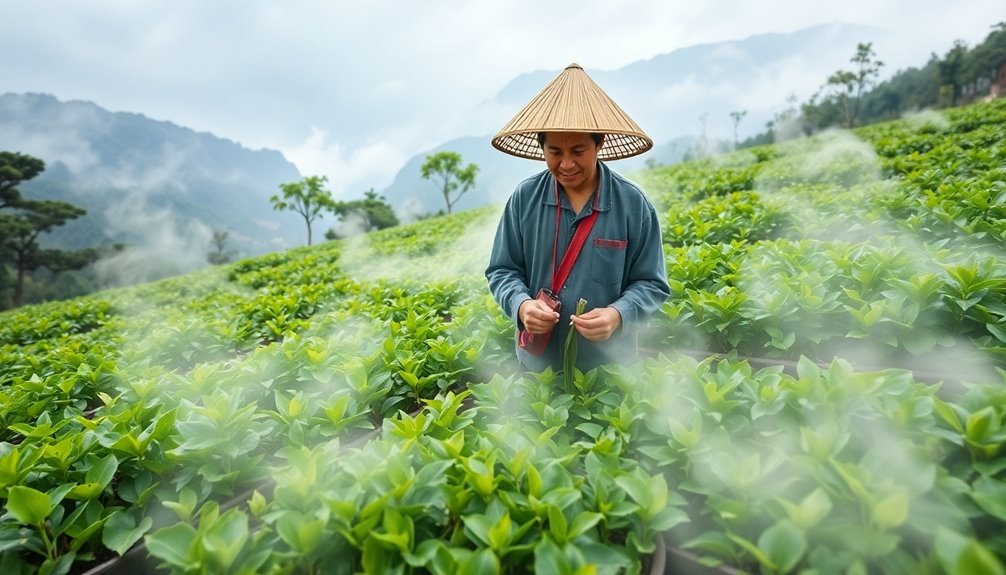
The fascinating history of tea traces back to ancient China, where its journey began around 2737 B.C.E. with Emperor Shen Nong's serendipitous discovery. As the story goes, leaves accidentally fell into his boiling water, creating a brew that would evolve into a cherished drink.
Initially, tea was valued primarily as a medicinal beverage, believed to have numerous health benefits. By 300 A.D., it transformed into a daily necessity for many, making its way into Chinese culture.
During the Tang Dynasty (618-907 A.D.), tea blossomed into a cultural staple. This period saw the creation of Lu Yu's "Cha Ching," the first definitive book on tea, detailing its preparation and significance.
The cultivation of tea expanded, with regions in southwest China, Tibet, and Northern India producing distinct varieties that endure today.
Cultural Significance in Rituals
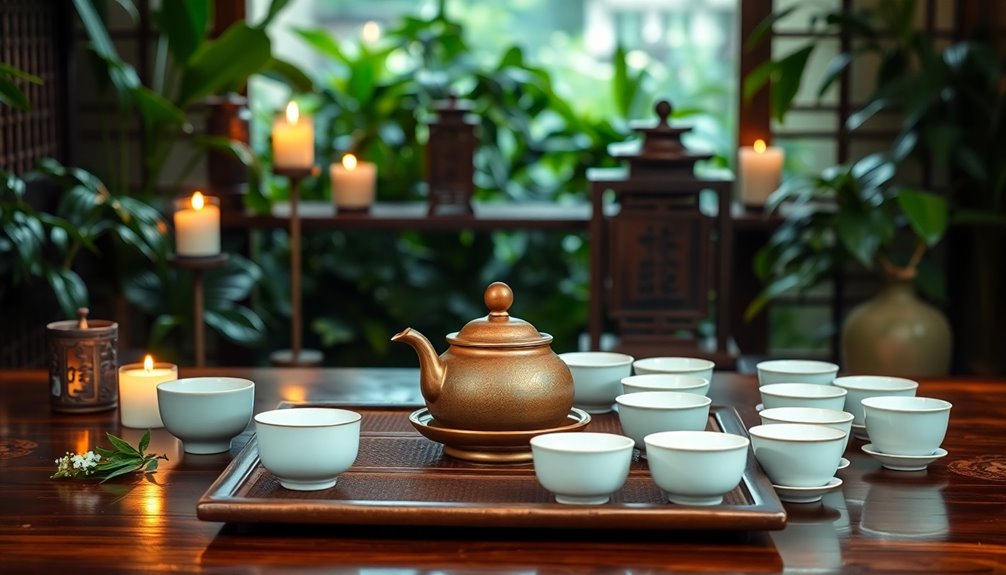
In many cultures, tea has transcended its role as merely a beverage, becoming a vital part of rituals and social practices. During the Tang Dynasty, tea culture blossomed, with the publication of Lu Yu's "Cha Ching," which highlighted the aesthetics and rituals of tea preparation.
In ancient China, tea supported spiritual practices, especially among Buddhist monks, aiding meditation and reflection.
The Japanese Tea Ceremony, or Chanoyu, evolved from these Buddhist traditions. It emphasizes mindfulness, aesthetics, and the social aspect of tea drinking, showcasing tea's deep cultural significance in Japan.
Similarly, in Islamic regions, brick tea replaced wine, becoming an essential social beverage that reflects hospitality and cultural adaptations.
In Britain, the ritual of afternoon tea, popularized by Anna Russell, the 7th Duchess of Bedford, emerged in the 1840s. This practice not only represented social status but also influenced global tea-drinking customs.
Through these diverse rituals, tea has woven itself into the fabric of various cultures, enriching social interactions and promoting mindfulness.
No matter where you are, the cultural significance of tea invites you to pause, reflect, and connect with others.
Tea as a Medicinal Herb
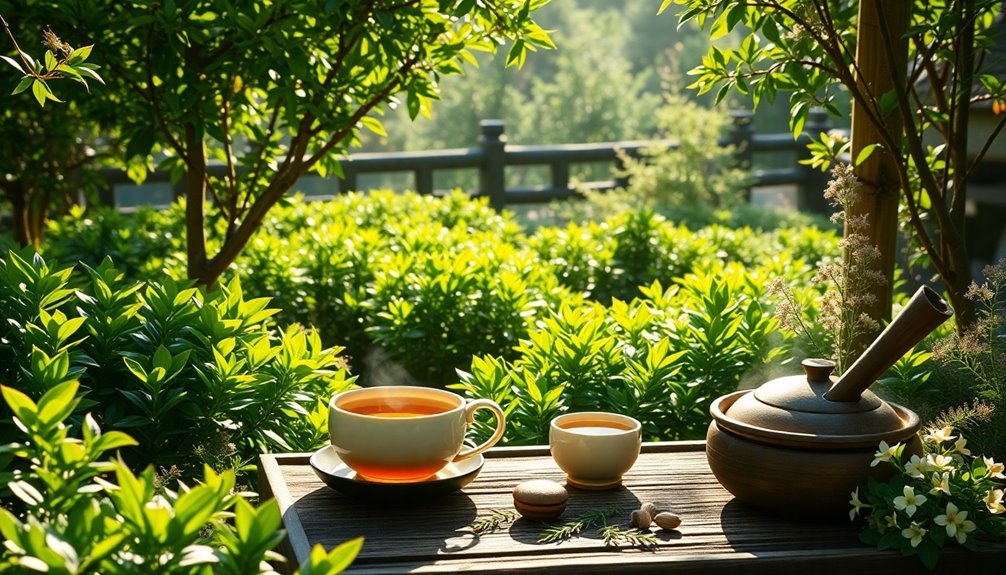
How did tea evolve from a simple medicinal herb to a beloved beverage worldwide? In ancient China, tea was revered for its healing properties, with Emperor Shen Nung reportedly discovering its benefits around 2737 B.C.E. Initially cultivated as a medicinal herb, it became known for promoting mind-body rejuvenation.
As tea gained popularity, particularly during the Tang dynasty, it transitioned from a health elixir to a cultural staple.
Lu Yu's "Cha Jing," written in the 8th century, played a crucial role in this transformation. It detailed various types of tea, their preparation, and the health benefits associated with consumption. This foundational knowledge helped establish tea as a significant part of improved health practices.
Boiling tea-water not only enhanced the flavor but also contributed to safer drinking habits, reducing waterborne diseases.
Today, modern studies highlight green tea's high antioxidant content and its potential health benefits, including promoting vascular health and reducing heart disease risk factors.
As you sip your cup of tea, remember its rich history as a medicinal herb, a journey that reflects centuries of cultural evolution and an enduring commitment to health and wellness.
Colonial Exploitation of Tea Trade
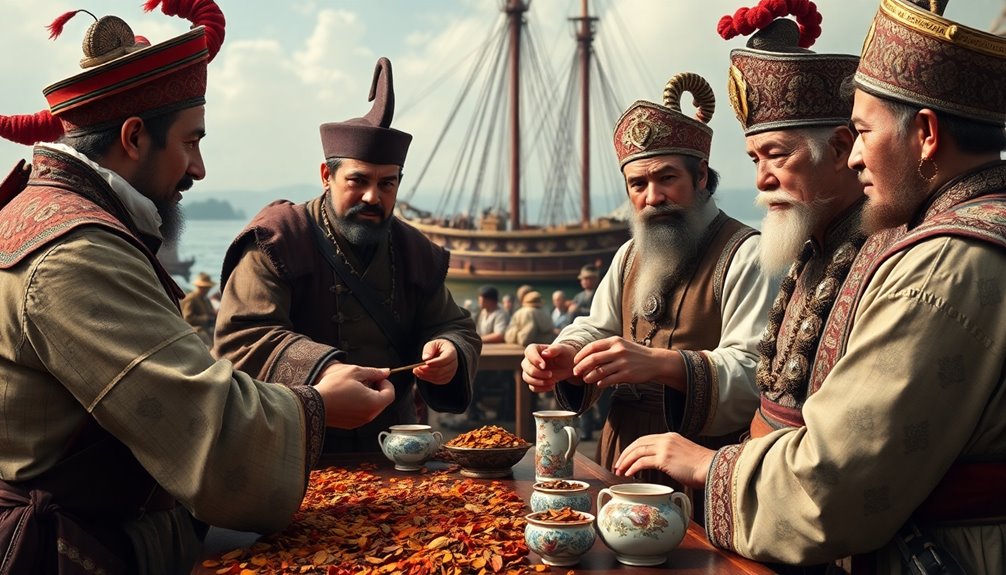
Exploiting the growing global demand for tea, the British East India Company manipulated political power and military force to establish a stranglehold on the tea trade with China in the early 1700s. This monopoly allowed them to control sourcing and distribution, maximizing their profits.
Following the First Opium War, they expanded tea plantations in colonial regions like Assam and Sri Lanka, exploiting local resources and labor to bolster profitability in the tea industry.
The Tea Act of 1773, which allowed the British East India Company to sell surplus tea directly to American colonists, sparked fierce resistance, culminating in the Boston Tea Party. Meanwhile, the demand for sugar-sweetened tea in Europe fueled the Atlantic slave trade, as sugar plantations relied heavily on enslaved labor to meet consumption needs.
However, the colonial tea plantations weren't without their issues. Labor unrest and rising costs reflected the socio-economic challenges of maintaining profitability in the tea industry amid shifting global dynamics.
The exploitation of tea not only transformed economies but also left a legacy of inequality and strife that would resonate for generations.
Practical Applications
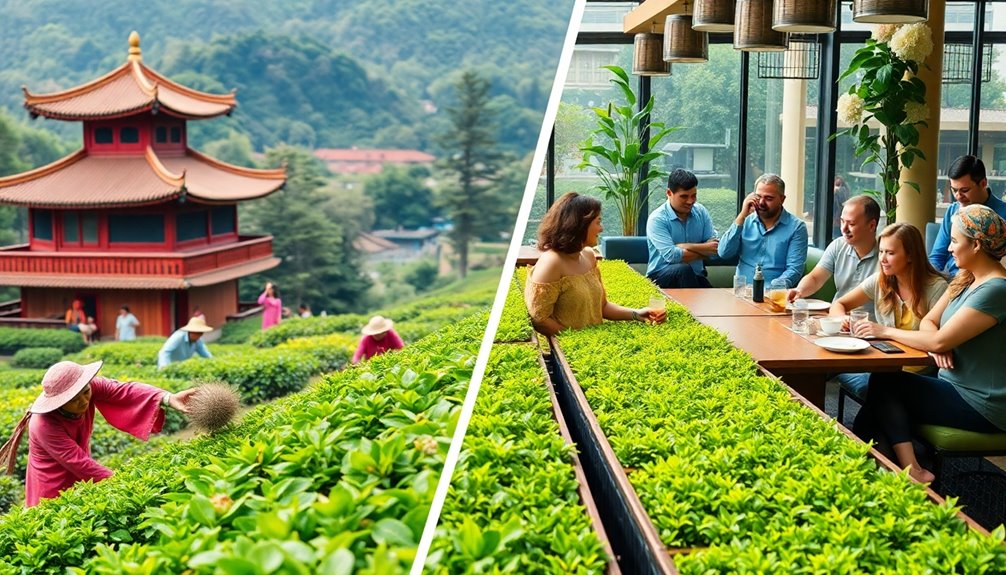
Tea's versatility extends beyond its rich history and cultural significance; it offers practical applications in daily life that enhance well-being and social interactions. As you engage in tea drinking, you not only enjoy a popular beverage but also tap into centuries of knowledge about its health benefits. The medicinal properties first discovered in ancient China continue to be relevant today, helping you relax, energize, or even improve digestion, including benefits linked to lower rates of depression. Additionally, certain teas, such as green tea, are shown to enhance memory retention, supporting overall cognitive health. Regular consumption of tea can also contribute to reduced cortisol levels, promoting a more relaxed state.
Through the tea industry, you can explore countless varieties, each with its unique flavor and health benefits. Whether you prefer delicate green tea leaves or robust black tea, there's a brew that fits your mood or occasion.
The British East India Company's pivotal role in tea trade shaped global consumption patterns, making tea a staple in households worldwide.
Historically, tea consumption also played a significant role in events like the American Revolution, where it symbolized resistance against British taxation.
Today, with over 600 million cups consumed daily in India, you're part of a worldwide community that appreciates this ancient beverage. Embracing tea in your daily routine can enhance social gatherings, foster connections, and promote wellness, making it a timeless practice worth celebrating. Additionally, exploring varieties like rooibos tea can further enrich your tea experience, offering unique flavors and numerous health benefits.
Conclusion
In conclusion, tea's journey from ancient China to the world is a fascinating tale of culture, health, and commerce. You've seen how it started as a cherished ritual, became a medicinal staple, and was later exploited during colonial times. Today, tea connects people across the globe, offering comfort and enjoyment in every cup. So, whether you sip it for its health benefits or relax with friends, remember the rich history behind this beloved beverage.


